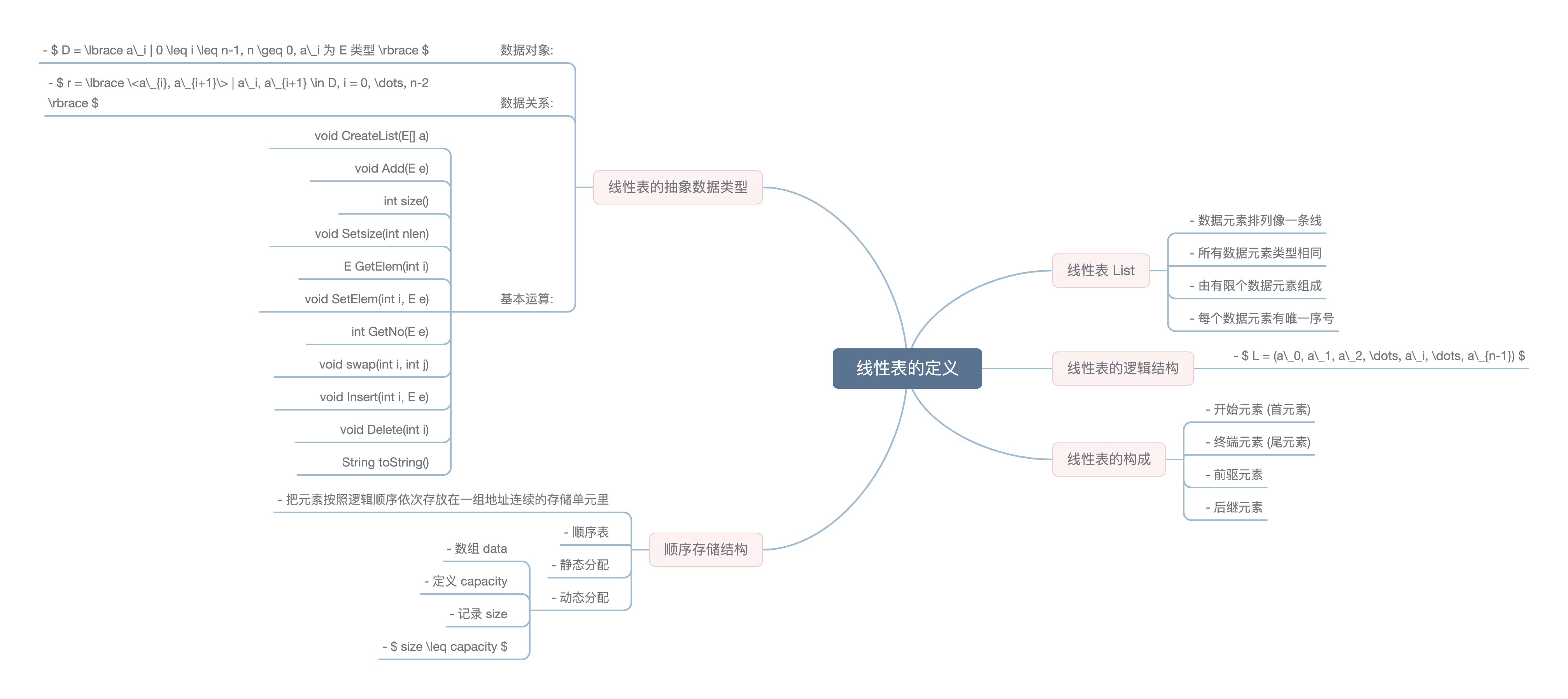### 线性表 List
- 数据元素排列像一条线
- 所有数据元素类型相同
- 由有限个数据元素组成
- 每个数据元素有唯一序号
### 线性表的逻辑结构
- $ L = (a\_0, a\_1, a\_2, \dots, a\_i, \dots, a\_{n-1}) $
### 线性表的构成
- 开始元素 (首元素)
- 终端元素 (尾元素)
- 前驱元素
- 后继元素
### 线性表的抽象数据类型
ADT List
{
数据对象:
$$ D = \lbrace a\_i | 0 \leq i \leq n-1, n \geq 0, a\_i 为 E 类型 \rbrace $$
数据关系:
$$ r = \lbrace <a\_{i}, a\_{i+1}> | a\_i, a\_{i+1} \in D, i = 0, \dots, n-2 \rbrace $$
ADT List
基本运算:
void CreateList(E[] a)
void Add(E e)
int size()
void Setsize(int nlen)
E GetElem(int i)
void SetElem(int i, E e)
int GetNo(E e)
void swap(int i, int j)
void Insert(int i, E e)
void Delete(int i)
String toString()
} ADT List
### 顺序存储结构
- 把元素按照逻辑顺序依次存放在一组地址连续的存储单元里
- 顺序表
- 静态分配
- 动态分配
### 动态分配
- 使用数组存储 `data`
- 定义数组大小 `capacity`
- 随时记录 `size`
- $ size \leq capacity $
### SqlistClass<E>
public class SqlistClass<E>
{
final int initcapacity = 10;
public E[] data;
public int size;
private int capacity;
public SqlistClass()
{
data = (E[]) new Object[init capacity];
capacity = initcapacity;
size = 0;
}
### updatecapacity(int newcapacity)
private void updatecapacity(int newcapacity)
{
E[] newdata = (E[]) new Object[newcapacity];
for (int i = 0; i < size; i++)
newdata[i] = data[i];
capacity = newcapacity;
data = newdata;
}
### CreateList(E[] a)
public void CreateList(E[] a)
{
int i,k = 0;
for(i = 0; i < a.length; i++)
{if (size == capacity)
updatecapacity(2 * size);
data[k] = a[i];
k++;
}
size = k;
}
- 时间复杂度 $ \mathcal{O}(n) $
### Add(E e)
public void Add[E e]
{
if (size == capacity)
updatecapacity(2 * size);
data[size] = e;
size++;
}
- 时间复杂度 $ \mathcal{O}(1) $
### size()
public int size()
{
return size;
}
- 时间复杂度 $ \mathcal{O}(1) $
### Setsize(int nlen)
public void Setsize(int nlen)
{
if (nlen < 0 || nlen > size)
throw new IllegalArgumentException(
"设置长度: n 不在有效范围内");
size = nlen;
}
- 时间复杂度 $ \mathcal{O}(1) $
### GetElem(int i)
public E GetElem(int i)
{
if (i < 0 || i > size - 1)
throw new IllegalArgumentException(
"取元素: i 不在有效范围内");
return (E)data[i];
}
- 时间复杂度 $ \mathcal{O}(1) $
### SetElem(int i, E e)
public void SetElem(int i, E e)
{
if (i < 0 || i > size - 1)
throw new IllegalArgumentException(
"设置元素: i 不在有效范围内");
data[i] = e;
}
- 时间复杂度 $ \mathcal{O}(1) $
### GetNo(E e)
public int GetNo(E e)
{
int i = 0;
while(i < size && !data[i].equals(e))
i++;
if(i >= size)
return -1;
else
return i;
}
- 时间复杂度 $ \mathcal{O}(n) $
### swap(int i, int j)
public void swap(int i, int j)
{
E temp = data[i];
data[i] = data[j];
data[j] = temp;
}
- 时间复杂度 $ \mathcal{O}(1) $
### Insert(int i, E e)
public void Insert(int i, E e)
{
if (i < 0 || i > size)
throw new IllegalArgumentException(
"插入元素: i 不在有效范围内");
if (size == capacity)
updatecapacity(2 * size);
for (int j = size ; j > i; j--)
data[j] = data[j -1];
data[i] = e;
size++;
}
- 时间复杂度 $ \mathcal{O}(n) $
### Delete(int i)
public void Delete(int i)
{
if (i < 0 || i > size - 1)
throw new IllegalArgumentException(
"删除元素: i 不在有效范围内");
for (int j = i; j < size - 1; j++)
data[j] = data[j + 1];
size--;
if(capacity > initcapacity &&
size == capacity / 4)
updatecapacity(capacity / 2);
}
- 时间复杂度 $ \mathcal{O}(n) $
### toString()
public String toString()
{
String ans = "";
for (int i = 0; i < size; i++)
ans += data[i].toString() + " ";
return ans;
}
- 时间复杂度 $ \mathcal{O}(n) $

### 9.1 线性表的定义
- 线性表的数据元素有什么特点?
- 在线性表中, 如何定义前驱元素和后继元素?
- Add(E e) 和 Insert(int i, E e) 有什么区别?
- 什么是静态分配和动态分配?
- 在顺序存储结构中, capacity 和 size 之间应满足什么条件?
----
[ 8.4 数据结构的目标](dbds-8-4.html#/overview)
[| 练习 |](dbds-exec.html)
[ 9.3 线性表的链式存储结构](dbds-9-3.html#/overview)